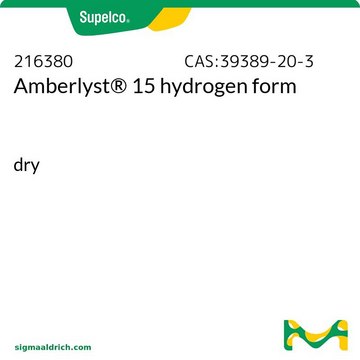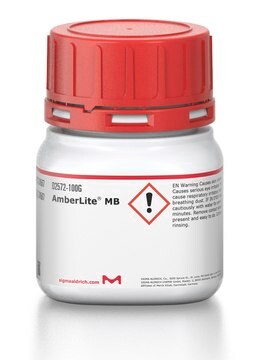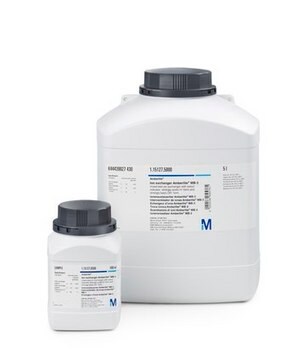Recommended Products
form
beads
Quality Level
crosslinking
12 % cross-linked
contains
51-57% Moisture content (H+ form)
composition
water, 55%
technique(s)
LPLC: suitable
surface area
33 m2/g
matrix
styrene divinylbenzene (macroporous)
matrix active group
sulfonic acid functional group
particle size
<0.425 mm (0.5% max)
0.600-0.850 mm (uniformity coefficient: <1.6)
>1.180 mm (4.0% max)
pore size
0.20 mL/g total pore volume
240 Å average pore diameter
capacity
>1.95 eq/L exchange capacity
>5.40 meq/g exchange capacity
density
1.2 g/mL at 25 °C (lit.)
separation technique
cation exchange
InChI
1S/C10H10.C8H8O3S/c1-3-9-7-5-6-8-10(9)4-2;1-2-7-5-3-4-6-8(7)12(9,10)11/h3-8H,1-2H2;2-6H,1H2,(H,9,10,11)
InChI key
SIWVGXQOXWGJCI-UHFFFAOYSA-N
Related Categories
General description
Water to phenol: 45%
Water to dry: 54%
Application
- Synthesis of renewable diesel and jet fuel range alkanes using 2-methylfuran and cyclohexanone.: This study explores a method for producing renewable diesel and jet fuel from biomass-derived compounds using Amberlyst® 36 as a catalyst, highlighting its potential for sustainable fuel production (Sun et al., 2022).
- Kinetic Study on Esterification of Acetic Acid with Isopropyl Alcohol Catalyzed by Ion Exchange Resin.: The research investigates the kinetics of esterification reactions catalyzed by Amberlyst® 36, providing insights into its efficiency and applicability in producing esters used in various industrial applications (Liu et al., 2019).
- Pretreatment of bio-oil with ion exchange resin to improve fuel quality and reduce char during hydrodeoxygenation upgrading with Pt/C.: This paper discusses the use of Amberlyst® 36 in the pretreatment of bio-oil to enhance its quality as a precursor for sustainable fuel, demonstrating the resin′s effectiveness in removing impurities that affect fuel refinement processes (Oh et al., 2021).
- Hydrolysis of Lipid-Extracted Chlorella vulgaris by Simultaneous Use of Solid and Liquid Acids.: The study examines the hydrolysis of algae-derived lipids using a combination of Amberlyst® 36 and other acids, showcasing its potential to facilitate biofuel production from microalgae (Seon et al., 2019).
- Valorization of lignocellulosic fibres of paper waste into levulinic acid using solid and aqueous Brønsted acid.: This research demonstrates the role of Amberlyst® 36 in converting paper waste into valuable chemicals like levulinic acid, contributing to waste valorization and chemical recycling (Chen et al., 2018).
Legal Information
Storage Class Code
11 - Combustible Solids
WGK
WGK 3
Flash Point(F)
Not applicable
Flash Point(C)
Not applicable
Personal Protective Equipment
Certificates of Analysis (COA)
Search for Certificates of Analysis (COA) by entering the products Lot/Batch Number. Lot and Batch Numbers can be found on a product’s label following the words ‘Lot’ or ‘Batch’.
Already Own This Product?
Find documentation for the products that you have recently purchased in the Document Library.
Our team of scientists has experience in all areas of research including Life Science, Material Science, Chemical Synthesis, Chromatography, Analytical and many others.
Contact Technical Service






